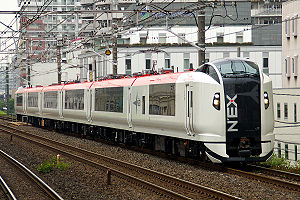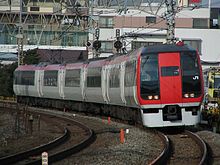- Narita Express
-
Narita Express 
Narita Express E259 series train Service type Limited express Operator JR East Maximum speed 130 km/h (80 mph)[1] Started 1991 Rolling stock E259 series EMUs Narita Express (成田エクスプレス Narita ekusupuresu), abbreviated as N'EX, is a limited express train service operated since 1991 by East Japan Railway Company (JR East), serving Narita International Airport from various Greater Tokyo Area stations. Services are approximately half-hourly in the mornings and evenings, and hourly through the middle of the day. The main competition for the Narita Express is Keisei Electric Railway's Skyliner.
Contents
Trains and destinations
Narita Express onboard display (E259 series) Legend


0:00 Narita Airport 


0:02 Airport Terminal 2 
0:16 Narita Rush hour only 
0:32 Yotsukaidō Rush hour only 
0:40 Chiba Rush hour only 
0:59 Tokyo 





1:09 Shinagawa 


1:16 Shibuya 


1:16 Shinjuku 


1:19 Musashi-Kosugi 





1:22 Ikebukuro 


1:31 Yokohama 


1:40 Kichijōji 


1:43 Mitaka 


1:52 Kokubunji 


1:54 Totsuka 


1:57 Ōmiya 


1:58 Tachikawa 


1:59 Ōfuna 


2:07 Hachiōji 


2:13 Takao Narita Express trains serve various stations in the Greater Tokyo metropolitan area. Trains are formed of dedicated E259 series 6-car EMU sets,[2] with all trains passing through Tokyo Station, where services are coupled or uncoupled. Usually, a train from Ōfuna or Yokohama will be coupled with a train from Shinjuku, Ikebukuro or Ōmiya to form one train set for the remainder of the journey to Narita Airport (via the Sōbu Main Line and Narita Line). On the return journey, the reverse is true.
The majority of Narita Express services do not stop between Tokyo and Airport Terminal 2 Station. In the morning and evening rush hours, however, the Narita Express serves as a commuter express, stopping at Chiba, Yotsukaidō and Narita. The average time between Tokyo and Narita Airport is between 55 minutes and an hour.
All seats are reserved, with both Standard and Green (first class) accommodation available.
Fares to major destinations
 Two 253 series trainsets prepare to couple at Tokyo Station for the onward journey to Narita Airport
Two 253 series trainsets prepare to couple at Tokyo Station for the onward journey to Narita Airport
Standard Class
From Narita Airport / Airport Terminal 2 to/from:
Destination Fare Surcharge Chiba ¥650 ¥1,240 Tokyo ¥1,280 ¥1,660 Shinjuku / Ikebukuro / Shibuya / Shinagawa ¥1,450 Musashi-Kosugi ¥1,620 Ōmiya ¥1,450 ¥2,290 Yokohama ¥1,890 Ōfuna / Totsuka / Hachiōji / Takao ¥2,210 Green Car (First Class)
Green Car seats can be reserved at a cost of ¥1,490, regardless of destination, in addition to the standard class fare.
Prior to June 2010, Narita Express services (using 253 series sets) also featured Green Car compartments seating up to 4 people. These could be reserved at a cost of ¥6,000 for the compartment, regardless of destination, in addition to the standard class fare.
Discounted fares for non-Japanese
Passengers holding a non-Japanese passport can purchase a joint Narita Express-Suica card package for ¥3,500 (standard class) or ¥5,000 (green class). ¥1,500 of the package covers a discounted Narita Express one-way fare to the greater Tokyo metro area (¥3,000 for green class) while ¥1,500 is put on the Suica card. The other ¥500 is a refundable deposit for the card. The Suica card can be used for train and bus fares in virtually all of the Tokyo metro area, as well as for certain establishments that welcome the card as a form of payment.[3]
A ¥5,500 round-trip can also be bought.[4]
History
Until 1991, rail service to Narita Airport was limited to the Keisei Skyliner, which at the time used a station separated from the terminal complex. JR had initially planned to run a high-speed line, the Narita Shinkansen, to a station underneath the main airport terminal. This plan was abandoned in the 1980s, and the space originally slated for the underground station and Shinkansen tracks was used to connect both the JR Narita Line and Keisei Main Line directly to the terminal. The Narita Express began service to the new station on 19 March 1991, and Skyliner switched its service to the new station at the same time.
Until March 2004, the Wing Express limited express service was introduced to complement the Narita Express with one return working a day between Ōmiya/Ikebukuro/Shinjuku and Narita Airport. This service was subsequently replaced by an additional Narita Express service.
From the start of the revised timetable on 10 December 2005, Narita Express services were made entirely no-smoking.[5]
On 1 October 2009, nine new E259 series EMU trains were brought into service on 10 of 26 return Narita Express services, replacing the 253 series.[6] By June 2010 all Narita Express trains were operated by E259 series equipment.[7]
From the start of the revised timetable on 13 March 2010, Narita Express service frequencies were increased with more splitting and combining of trains at Tokyo Station. Service is provided between Narita Airport and Tokyo, Shinjuku and Yokohama every 30 minutes during most of the day. All trains operating to/from Shinjuku now stop at Shibuya, and all trains to/from Yokohama now stop at the new Musashi-Kosugi Station.[8]
Narita Express services were suspended from 11 March 2011 due to the 2011 Tōhoku earthquake and tsunami and subsequent power supply shortage in the Tokyo area.[9] They were partially restored from 4 April 2011.[10]
References
- ^ JR新幹線&特急列車ファイル [JR Shinkansen & Limited Express Train File]. Japan: Kōtsū Shimbun. 2008. p. 64. ISBN 978-4-330-00608-6.
- ^ JR Timetable, October 2009
- ^ "JR-EAST: Suica & N'EX". East Japan Railway Company. March 2009. http://www.jreast.co.jp/e/suica-nex/index.html. Retrieved 27 May 2009.
- ^ "Suica & N'EX Narita Express JR-EAST= East Japan Railway Company". October 2010. http://www.jreast.co.jp/e/nex/suica_nex.html. Retrieved 5 October 2010.
- ^ "December 2005 Timetable Revision Details" (in Japanese) (pdf). Japan: East Japan Railway Company. 30 September 2005. http://www.jreast.co.jp/press/2005_1/20050915.pdf. Retrieved 6 February 2009.
- ^ "E259系「成田エクスプレス号」10月から10往復程度が運用開始 (10 E259 series "Narita Express" workings to commence from October)". Tetsudō Daiya Jōhō (Japan: Kōtsū Shimbun) 38 (305): p74. September 2009.
- ^ "JR東日本 E259系特急型直流電車 (JR East E259 series limited express DC EMU)". Tetsudō Daiya Jōhō (Japan: Kōtsū Shimbun) 38 (303): p70–71. July 2009.
- ^ "2010年3月ダイヤ改正について" (Press release). East Japan Railway Company. 2009-12-18. http://www.jreast.co.jp/press/2009/20091215.pdf. Retrieved 2010-01-30. (Japanese)
- ^ "Service Operation Status" (in Japanese) (pdf). Japan: East Japan Railway Company. 2011-03-28. http://www.jreast.co.jp/pdf/untenkeikaku.pdf. Retrieved 2011-03-29.
- ^ "JRの運行状況 2日 [JR Operation Status - 2 April]" (in Japanese). NHK News. Japan: Japan Broadcasting Corporation. 2011-04-02. http://www3.nhk.or.jp/news/html/20110402/k10015061541000.html. Retrieved 2011-04-02.
External links
 Media related to Narita Express at Wikimedia Commons
Media related to Narita Express at Wikimedia Commons- About N'EX (JR East) (English)
- 253 series Narita Express (JR East) (Japanese)
- E259 series Narita Express (JR East) (Japanese)
Named trains of East Japan Railway Company Shinkansen 
Limited express (daytime) Akagi · Akita Relay · Ayame · Azusa · Fresh Hitachi · Hakuchō · Hakutaka · Hatsukari · Hokuetsu · Hometown Tochigi · Inaho · Kaiji · Kamoshika · Kinugawa · Komakusa · Kusatsu · Minakami · Minori · Narita Express · Nikkō · Odoriko · Ohayō Tochigi · Sazanami · Shiosai · Spacia Kinugawa · Super Azusa · Super Hakuchō · Super Hatsukari · Super Hitachi · Super View Odoriko · Tazawa · Tsugaru · Wakashio · Weekend AkagiLimited express (overnight) Express Rapid Airport Narita · Aizu Liner · Kubikino · Moonlight Echigo · Moonlight Nagara · Moonlight Shinshū · Musashino (partial list)Liner Categories:- East Japan Railway Company
- Named passenger trains of Japan
- Airport rail links in Japan
- Rail transport in Tokyo
- Rail transport in Chiba Prefecture
- Rail transport in Kanagawa Prefecture
- 1991 introductions
- Narita International Airport
Wikimedia Foundation. 2010.


